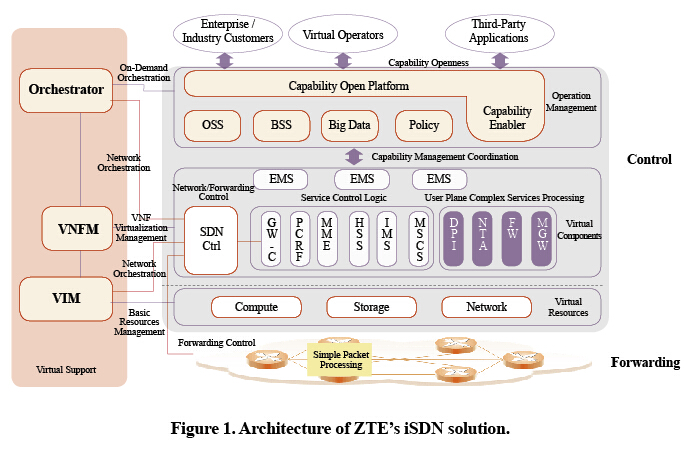ZTE’s iSDN Solution for a Sustainable Telecom Network
Many dedicated telecom devices and complicated network O&M leads to high TCO. Enclosed telecom services and long service provisioning timeframes make operators less competitive with OTT providers in light of fast-paced innovation. High expenditure and decreasing profits have put operators in the position of having to learn from failure and comprehensively transform themselves. In this context, building an innovative, efficient, green telecom network is a top priority.
Virtualization technologies offer operators a way out of their predicament. When introduced in a telecom network, network function virtualization (NFV) technology decouples software from hardware, frees telecom devices from dedicated hardware, generalizes IT-based telecom hardware, and greatly reduces the cost of hardware procurement. NFV promotes resource sharing for better hardware use, and generalized IT-based hardware enables new third-party services to be introduced. Operators have wanted these things for a long time.
However, NFV also raises new issues for operators:
● NFV is now built on the x86 platform, which forwards and processes packets less efficiently than traditional routers and switches. Operators are concerned about this when they try to promote virtualization of user-plane NEs.
● Although numerous virtual components can be created by NFV, organizing them so that network services can be provided flexibly is very complicated.
● NFV enables massive new value-added services to be provided. However, scheduling these services according to user and service flow characteristics to maximize virtualization is still problematic.
The rapid development of SDN in recent years can help operators solve problems. SDN separates the control function of a routing device from its forwarding function and changes the way network routing is managed. Previously, routers were configured separately, but now forwarding policies are generated on the control plane and implemented on each forwarding point. In this way, network routing maintenance becomes simpler, more flexible, and more dynamic. Furthermore, by opening northbound interfaces, SDN allows third-party applications to control service routing.
To assist operators solve problems in network virtualization, ZTE has launched an iSDN solution that incorporates NFV and SDN technologies (Fig. 1).

The iSDN, which rides on NVF and SDN technologies, separates control from forwarding in a telecom network. Specifically, the components used for O&M, service control, and user-plane complex service processing on the control layer are created using virtualization technologies. The forwarding plane efficiently encapsulates, decapsulates, and forwards packets and collects packet information according to the control-plane strategy. The network is based on the latest ETSI NFV architecture and introduces a big-data platform, strategy platform, and open-capability platform. These work together with the BSS and OSS to enable intelligent network O&M. All components on the control plane can be created according to external requirements, obtained from the open-capability platform, and real-time status, obtained from the big-data platform. SDN is then used to automatically manage and orchestrate the overall network topology and service routing.
In ZTE’s iSDN solution, SDN is used in the user-plane NE (GW), for orchestration of network services, and for service chaining for value-added services.
With an SDN-based GW, the control plane and forwarding plane, which are usually integrated in an existing GW, are separated from each other. The control plane GW-C can be virtualized for centralized deployment and the forwarding plane can be deployed in a flat, distributed manner in order to rapidly offload traffic. Furthermore, the forwarding plane of an SDN-based GW is no longer subject to the x86 platform and can be embedded with cost-efficient hardware chips, such as ASIC and MIPS chips. In this way, the packet forwarding of a virtualized user-plane NE is increased.
The orchestrator in the NFV architecture can create required network components, but these are only isolated entities and cannot provide complete network services. When SDN is introduced, the orchestrator can use the SDN controller to control the open-flow switch (OFS) on the forwarding plane and automatically orchestrate network components. The orchestrator manages network topology and network component lifecycles in a unified way. It works together with the open-capability platform, which collects external requirements; the big-data platform, which analyzes the current status of the network, users and services; and the strategy platform, which develops strategies. In this way, the orchestrator forms a closed control loop for more flexible, efficient O&M of network services.
In the mobile core network, the components that provide value-added services for users are deployed between the GW and service network. The existing GW can only follow a specified routing policy to forward packets. These packets have to pass all relevant value-added services successively thereby making provision of services much less flexible and decreasing the utilization of components. When SDN is introduced, these components can be mounted on the OFS, and the orchestrator can be used to manage both the lifecycles of the components and service chain selection rules.
Specifically, the orchestrator sends the service chain selection rules to the PCRF, which instructs the GW to label service flows according to user and service flow characteristics. The orchestrator also sends the label routing rules to the OFS through the SDN controller, instructing the OFS to route service packets to the corresponding VAS components according to the service flow labels in a given order. The orchestrator adjusts the service-chain selection rules and synchronizes the changes with the OFS according to the number and statuses of value-added services in the network. Therefore, all the VAS components can be orchestrated in real time, and user flow, service flow, and actual states of these components can be reflected. This allows the VAS components to be scheduled more effectively.
ZTE’s iSDN solution combines NFV with SDN so that a telecom network can be adapted by the customer to different network states. This creates an intelligent, efficient, low-consumption network capable of adaptively providing value-added services. ZTE’s iSDN solution helps operators rapidly transform themselves and is central to evolving current telecom networks towards 5G.